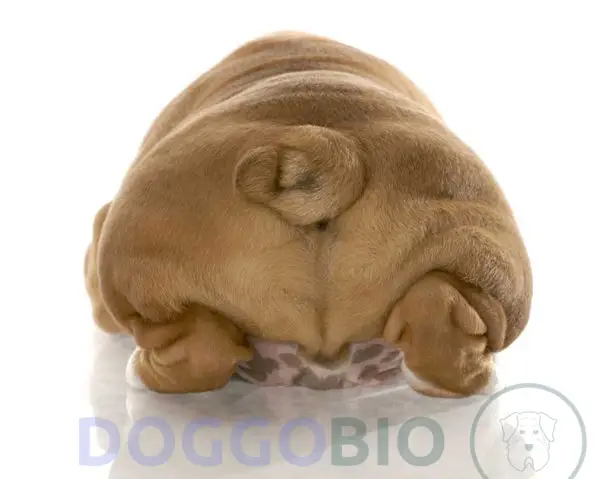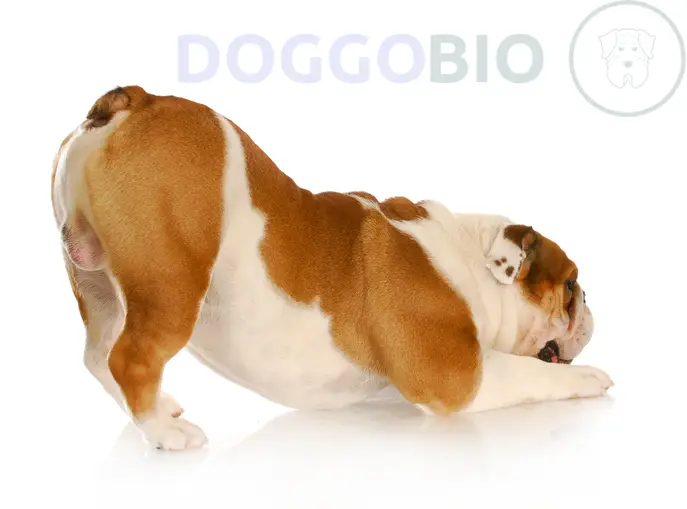English Bulldogs are a popular breed of dog known for their distinctive wrinkled faces and affectionate personalities. They have been bred for various purposes throughout history, including bull-baiting and guarding livestock.
However, if you’ve ever found yourself wondering about the peculiarities of an English Bulldog’s physical appearance, one question that often arises is: “Do English Bulldogs have tails?”
In this article, we’ll address common questions about English Bulldogs and explore the truth behind their tail-related mysteries, shedding light on these beloved companions’ history, traits, and potential tail variations. Whether you’re a curious dog enthusiast or an aspiring Bulldog owner, prepare to unravel the truth about one of the most intriguing aspects of the English Bulldog’s anatomy.
Do English Bulldogs Have Tails?

Yes. English Bulldogs are born with tails, but their tails are substantially shorter than most dog breeds’ tails. The tails of English Bulldogs consist of coccygeal vertebrae, which are called tail bones. Full-tailed dogs typically have 19 to 23 coccygeal vertebrae, while English Bulldog tails have only 6 to 13.
However, some English Bulldogs may appear to have no tails despite being born with tails. This is due to the different types of English Bulldog tails, which can vary in length and appearance. Some Bulldogs may have tails that are very short and barely visible, while others may have tails that are longer but still shorter than those of many other dog breeds.
So, in summary, English Bulldogs do have tails, but the length and appearance of their tails can vary.
What is a English Bulldog?

The English Bulldog breed, or simply the Bulldog, is a highly recognizable canine breed with a squat, heavily built frame, jowly and wrinkled faces, and a pronounced underbite. It is worth noting that the name “English Bulldog” is often utilized to differentiate the breed from other bulldog breeds, such as the American Bulldog or the French Bulldog. Furthermore, it is essential to distinguish the English Bulldog from Olde English Bulldogges, a separate species altogether.
The English Bulldog’s unique and characteristic appearance has earned it an iconic status, with its pushed-in faces inextricably linked with the Marine Corps in the United States and closely associated with the famous wartime Prime Minister, Winston Churchill, in the UK. The breed’s popularity has steadily grown over the years, with the American Kennel Club (AKC) ranking it as the 5th favorite dog breed among the American people since 2013.
Why Do Bulldogs Have Short Tails?
The English Bulldog boasts a distinctive, short tail that sets it apart from other breeds. This unique tail trait can be traced back to its historical role as a working dog on farms and in bull-baiting during the 15th century.
Originally bred to assist butchers and manage livestock, Bulldogs needed tails that were less prone to injury while navigating the rugged terrain of farms. As a result, selective breeding favored Bulldogs with shorter tails, leading to the prevalence of tiny tails in the breed today.
While the English Bulldog’s role has shifted from a working dog to a loyal companion, its short tail remains a defining characteristic, preserved in the breed standard. This historical legacy continues to influence the Bulldog’s appearance, whether in a straight or screwed tail, and remains a testament to its rich heritage.
Understanding English Bulldogs With Tails
The breed is renowned for its distinct physical features, and the breed standard outlines the ideal characteristics a Bulldog should possess.
Regarding Bulldog tails, the breed standard specifies that they should exhibit either a straight or a screwed appearance. It is important to note that the breed standard opposes any hint of curvature or curliness in the tail structure.
Furthermore, Bulldog tails are anticipated to be relatively short, featuring a thick base that tapers off to a fine tip. As per the breed standard, Bulldog tails must always be seen hanging or corkscrewing downwards from their base.
1. The Straight Tails

Straight tails, the most ubiquitous of all Bulldog tails types, have been approved by the American Kennel Club to show standard dogs.
It is widely believed by many that straight tails are the most sought-after tail type since they don’t come with any accompanying health issues.
It’s worth noting that straight tails are only a mere couple of inches long, and it is their natural length, not a result of being cropped in puppyhood.
2. The Curly Tails

The curly tail type, which undulates in a carefree manner akin to a pig’s tail, or folds back over itself resembling that of a Basenji’s tail, is deemed by the Bulldog breed standard as the least desirable of all tail types.
Due to their unfavorable status, breeders make it a point to circumvent producing litters of puppies that have curly tails, making it a rarity to spot them.
3. The Screw Tails

Screw tails are twisted and coiled tightly in a series of kinks, creating an appearance akin to a bun snugly nestled against the body.
Bulldog pups with screw tails are born with bones and spaces between them still pliable enough to permit gentle unfurling.
However, the bones solidify as they mature and become fixed in place. While show dogs can sport this tail type, it is saddled with a few weighty health issues.
What is a Tail Pocket on an English Bulldog?
A tail pocket is an area of the skin with deep folds that emerges beneath the tail of an English Bulldog. Due to their numerous skin folds, Bulldogs are predisposed to developing this little pocket. If this skin is not cleaned frequently, dirt and moisture can accumulate, leading to inflammation and, eventually, infection.
In conclusion, it is imperative to keep an eye on this area and maintain proper hygiene to prevent any health issues from arising.
English Bulldog Tails Problems
English Bulldog tails may appear cute and harmless, but they can have severe health problems.

1. Skin Infections
Have you heard about tail fold pyoderma? It’s an absolute nightmare for screw-tail English Bulldogs! Because their tails are tightly twisted and sit so close to the body, they often experience friction and irritation against their bums.
And that’s when the problems start – bacteria and fungi seize the opportunity to enter the body through the inflamed skin, and before you know it, infections take hold!
The warm and moist environment underneath the tail only makes it worse. Sometimes, antibiotics can help to clear up the infection, but if it keeps coming back, the only option is to remove the tail altogether through surgery.
2. Spinal Column Malformations
Another complication that is more spine-tingling is spinal column malformations. English Bulldogs with screw tails are more likely to develop spinal column malformations than those with straight tails.
These malformations include spina bifida and cranial thoracic vertebral canal stenosis (CTVC). Spina bifida is a condition where the vertebrae do not fully enclose the spinal cord nerves, whereas CTVC occurs when the vertebrae are malformed, compressing the spinal cord. Male Bulldogs in their early years are more prone to CTVC than other dogs. And brace yourselves: the treatment for these conditions often requires surgery!
Surrounding about English Bulldog Tails Docking
Tail docking is a controversial practice that involves removing part of a dog’s tail. Historically, tail docking was done to protect working dogs from tail injuries and to avoid paying taxes on non-working dogs. Nowadays, some pet owners still dock their dogs’ tails to conform to breed standards. However, this practice is widely considered unnecessary and potentially harmful to the animal’s welfare.
English Bulldogs, known for their naturally short tails, do not require tail docking. However, in some cases, they may need to amputate bulldog tails due to health problems like tail fold pyoderma or spinal column malformations. A qualified veterinarian with proper training and experience should only perform this procedure. Pet owners must prioritize their pets’ well-being over conforming to outdated breed standards.
Does It Hurt a Dog to Have Its Tail Cut Off?
Yes. Cutting off a dog’s tail can be painful for the dog. The tail is an extension of the dog’s spine, and removing it without proper care and anesthesia can cause significant pain and distress to the animal.
However, if tail amputation is necessary for medical reasons, a veterinarian can perform the procedure using anesthesia. This surgical tail amputation is a safe and painless method to remove the tail while ensuring the dog does not experience unnecessary suffering. It is crucial to rely on a qualified veterinarian to assess and carry out such procedures to minimize any pain or discomfort for the dog.
Some Posts You Wanna Read More
- Chocolate French Bulldog
- Blue American Bulldog
- Black English Bulldog
- How Long Do Bulldogs Live?
- American Bulldog Johnson
- Mini French Bulldog
- Do French Bulldogs have Blue Eyes?
- Fluffy French Bulldog
- Grey French Bulldog
Frequently Asked Question
1. Are Bulldogs born with the long tail?
No. Bulldogs are not typically born with long tails. While some Bulldog breeds, like American Bulldogs and Olde English Bulldogs, may have naturally long tails, English Bulldogs and French Bulldogs usually do not have long tails.
It’s worth noting that having a long tail on a Bulldog may be considered unusual in breed standards, and it could disqualify them from dog shows, according to the American Kennel Club. However, many experts consider a long tail to be a healthy feature for Bulldogs and not a defect. So, if you happen to have a Bulldog with a long tail, it’s something to enjoy and appreciate.
2. Can Bulldogs’ tails be docked?
No, Bulldogs’ tails should not be docked. Docking, the process of surgically removing a portion of the tail, is considered unnecessary and inhumane for Bulldogs. In many countries, it is also illegal to dock the tails of dogs for cosmetic purposes. Bulldogs are naturally born with their tails, and it is recommended to leave them intact.
3. How should I care for my Bulldog’s tail?
Caring for your Bulldog’s tail is relatively easy. Regular cleaning is important to maintain good hygiene. Gently wipe the tail area with a damp cloth or pet-safe wipes to remove any dirt or debris. Pay attention to any signs of irritation or infection, such as redness, swelling, or discharge.
If you notice any concerning symptoms, consult your veterinarian for proper diagnosis and treatment.
4. Are Bulldogs with long tails more prone to injuries?
No, Bulldogs with long tails are not necessarily more prone to injuries. Bulldogs, regardless of their tail length, should be kept in a safe and secure environment to minimize the risk of tail injuries or accidents.
Providing a well-padded and comfortable space for your Bulldog to rest can also help prevent any potential tail-related discomfort or injury.
Conclusion
In conclusion, the question of Do English Bulldogs have tails has been thoroughly explored. While it is true that English Bulldogs possess tails, they are often short, low-set, and tightly curled, giving them a distinct appearance.
The breed has undergone various physical changes over time, and tail docking was a common practice to prevent injuries during bull-baiting. However, as the breed shifted towards being a companion animal, tail docking became less common and even illegal in some countries.
Despite the breed’s physical differences, English Bulldogs remain beloved pets and loyal companions to many.

Pingback: How Long Do French Bulldogs Live? Nurturing a Lifetime 2023